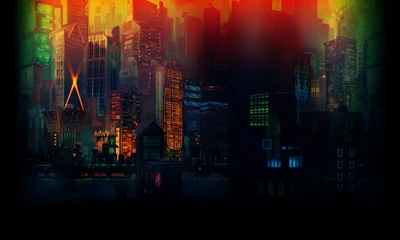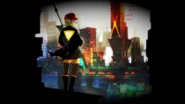
A Cloudbank skyline
Everybody has a voice in Cloudbank. --Reveal Trailer
Cloudbank is the city in which the majority of Transistor takes place. It is home to Red, the Camerata, and all the other characters of the game, and is under attack from the Process.
Architecture
Cloudbank is a densely populated urban area, with many tall buildings packed closely together. The city has multiple vertical layers, connected by staircases and gondolas. Some blocks are connected by bridges suspended in the sky, and there are highways running through the city. The buildings feature a menagerie of design styles, but equilateral triangles serve as somewhat of a common design element, as it does throughout the game.
Politics
The city is overseen by Cloudbank Central Administration and operated on a completely democratic basis. Popular votes, carried out via OVC terminals, dictate every aspect of Cloudbank's environs. If the people vote for a building to change shape, or for the sky to change color, or the weather to be different, it will happen.
While the voting system attempts to ensure that "everyone has a voice," some citizens choose to be nonvoters and marginal perspectives with fewer voteshares can end up sidelined, potential problems which Niola Chein attempted to solve through education and activism in her district. The ubiquity of the system also colored the city's history with transience and volatility, leading to the formation of the Camerata, a group disillusioned by how quickly public opinion could foment change.
Districts
Cloudbank, being a very large area, has several districts. Not every area is accessible through gameplay, but many are explorable.
Goldwalk
Goldwalk is the northwestern district of the city. The area features the Empty Set and Junction Jan's, as well as the Canals District with its seventeen public houses. The suitor of famous skypainter Farrah Yon-Dale lived in Goldwalk, and numerous community improvement efforts by resident Niola Chein included the controversial opening of the Goldwalk Channel.
Highrise
A neighboring district to Goldwalk, Highrise is the home of Red and the Highrise Hammers, including their troubled star quarterfielder, Olmarq. The district is far from the water. Other notable features include Traverson Hall, the Annex Building, and Bracket Towers, home of Central Administration.
A planned metro from Highrise to Goldwalk was outvoted in favor of the Goldwalk Channel, drawing ire from those who wanted the bridge.
Fairview
Fairview Island, accessible only by air and sea, is known as Cloudbank's most secluded and beautiful getaway. There is a petition for a footbridge to Fairview from the southeast edge of Goldwalk Bay.
Sunset
Sunset is home to the Sunset Clientele. It is the only district never visited in the game.
Sandbox
The Sandbox, accessible via backdoors throughout the town, is a private island created by Sybil Reisz. It functions at a remove from the rest of Cloudbank, having its own internal ecosystem and being shielded from the effects of the Spine.
A Virtual World?
- A prevailing fan theory is that Cloudbank is not really a city, but a virtual simulation, or some other world inside of a computer system. There are a great deal of computer-related motifs in the game ("firewalls," "terminals" and "administrators" to name a few), including the name of the city itself ("cloud" computing can take place over a data "bank").
- When Red and the Transistor visit Junction Jan's in the Goldwalk district, they are able to use an OVC terminal to order takeout food - but there is no mention of paying for it. In fact, there is no mention of money being used for anything in Cloudbank - people's careers seem to exist only to occupy their time or describe their ambitions. We see no poverty or class struggle; everyone seems to coexist with little or no conflict. This may imply that currency is not used at all, and possibly may never have been used in Cloudbank. In this way, Cloudbank is a strange opposite to the typically dark dystopia found in similar cyberpunk fiction. Instead, it is a post-scarcity society.
- All of the Transistor's powers are named as if they were programming functions, right down to the parentheses. Breach(), for example, would be valid syntax in most programming languages for calling or defining a nullary function named Breach.
- When a fight ends in Transistor, the line "Process Terminated" appears. In software programming, a process is an is an instance of a computer program that is being executed, i.e. being actively run by the CPU. To terminate a process is to stop it before it completes.
- By that reckoning, the Process could be some kind of malware or computer virus, set loose upon the system, and determined to erase everything on it (much like formatting a hard drive). Late in the game, Royce explains that the Process are the original forces responsible for the constant changing of the city, though the question of how, or where they came from, is never explored.
- The citizens themselves may not even be human, since their Traces (essentially their "souls") can be downloaded and stored on the Transistor as if they were data, without need for their bodies to exist. Additionally, "trace" is a programming term for a record of all the steps taken by an individual program.


